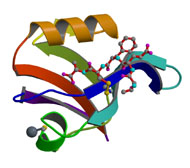Resources
The R. L. Juliano Structural BioInformatics (SBI) Core Facility, located in 3079 Genetic Medicine building, is a unique resource providing researchers access to computational structural biology tools that will optimally enhance their scientific studies. The director, Dr. Venkata Chirasani is available for collaborative studies or for training researchers in computational structural biology techniques.
Computational Tools
The SBI core offers access to state-of-the-art computers. Eleven Silicon Graphics workstations (4 R5000 O2s, 2 R10000 Octanes, 4 Dual R12000 Octane2s, 1 Origin 200) selected specifically for their stereographic imaging and powerful numerical processing capabilities are available to faculty and students. Available computational tools, many freely available on the web, include protein and DNA sequence analysis (Muscle, T-Coffee, ClustalX, Seaview, Mega5.2.1), protein fold determination (HHpred, I-Tasser), structure superimposition and comparison (PyMOL), homology modeling (Modeller), active site identification (Discovery Studio, Sybyl), analyzing effects of mutations, docking of drugs (ClusPro, Zdock), and molecular dynamics (AMBER, NAMD, Gromacs). These analyses are typically run on local MacBook Pro workstations within the facility, but computational resources made available through ITS Research Computing, particularly the Dell blade-based linux cluster killdevil with 32 GPU and 674 compute nodes along with a StorNext mass storage system, are utilized when needed for the more computationally demanding projects such as molecular dynamics simulations and whole genome calculations.
Available Software Packages
The facility offers access to state a variety of software packages for structure visualization, modeling and analysis. Researchers are trained in software tools for protein and DNA sequence analysis, protein fold determination, structure superimposition and comparison, homology modeling, active site identification, mutation effects analysis, and drug docking. Available software packages include SYBYL, Insigtht II, FELIX, QUANTA, spock, VMD, CCP4, AMBER, crystallography or NMR spectroscopy.
Sequence Analysis
 Multiple sequence alignments, phylogenetic analysis, ancestral sequence predictions, secondary structure predictions, domain prediction, functional residue prediction
Multiple sequence alignments, phylogenetic analysis, ancestral sequence predictions, secondary structure predictions, domain prediction, functional residue prediction
Structure Visualization and Analysis
Structure visualization, electrostatic surfaces, homology modeling, amino acid mutation analysis, solvent accessibility calculations, subunit contact analysis, molecular dynamics calculations, free energies of binding, active side identification, docking of small molecules, figures for grants and publications, molecular movies for presentations.